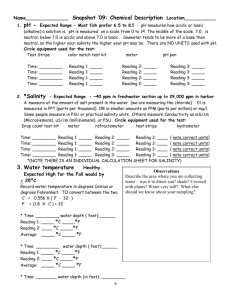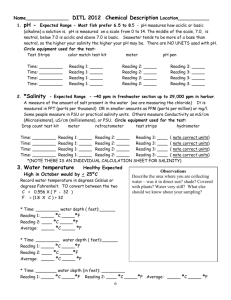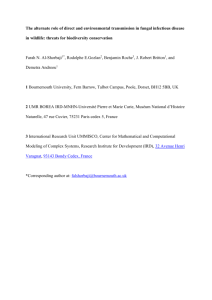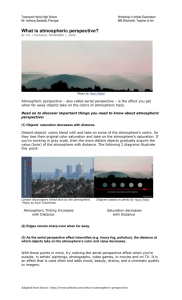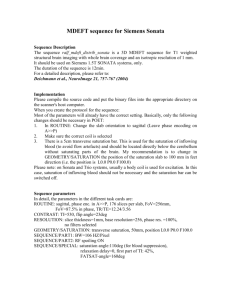keyPETE311_06A_Exam3-2A_JBM
advertisement
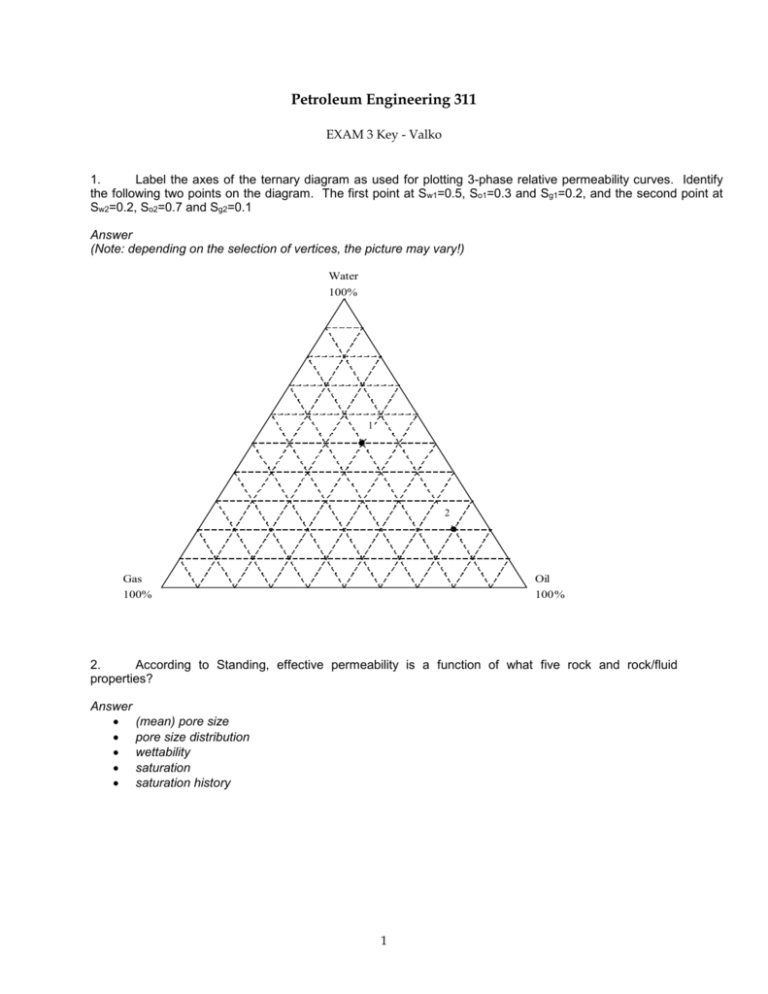
Petroleum Engineering 311 EXAM 3 Key - Valko 1. Label the axes of the ternary diagram as used for plotting 3-phase relative permeability curves. Identify the following two points on the diagram. The first point at Sw1=0.5, So1=0.3 and Sg1=0.2, and the second point at Sw2=0.2, So2=0.7 and Sg2=0.1 Answer (Note: depending on the selection of vertices, the picture may vary!) Water 100% 1 2 Gas Oil 100% 100% 2. According to Standing, effective permeability is a function of what five rock and rock/fluid properties? Answer (mean) pore size pore size distribution wettability saturation saturation history 1 3. Beginning with Darcy’s Law for 1-D Linear flow of a specified phase, derive the fractional flow equation shown below for the two phase case. You may assume horizontal flow and negligible capillary pressure. f wet q wet q wet q nonwet 1 k r ,nonwet wet 1 k r , wet nonwet Answer k wet L wet q wet A qnonwet A k nonwet L nonwet Since the flow is horizontal and capillary pressure can be neglected, the flow potential difference is the same for both phases. Therefore we can cancel the terms containing area, length, and flow potential: f wet q wet q wet q nonwet 1 1 k nonwet wet k wet nonwet k wet k wet L wet wet 1 k wet k nonwet k nonwet wet k wet k nonwet A A 1 L wet L nonwet wet nonwet nonwet k wet A 1 1 k r ,nonwet wet k r , wet nonwet where we also used the fact that the base permeability cancels out. 4. Define and explain the Capillary End Effect and describe how this can affect laboratory relative permeability measurements. Answer: During steady-state immiscible displacement in the bulk of the core plug there is a constant saturation and the capillary pressure corresponds to it. At the outflow face, however, the capillary pressure is zero and hence the wetting phase saturation is one. (This happens because the core is in contact with the wetting fluid that has left the core. The capillary effect "sucks back" some fluid, the same way as the formation "sucks up" water above the free water level.) Therefore, whatever the wetting phase saturation is in the bulk core, at the outflow end face it approaches 1. The locally large wetting phase saturation causes a distortion in the phase composition of the outflowing fluid. In other words, we observe more wetting phase coming out than it would be according to the bulk saturation condition. This is called "end capillary effect". [There are various ways to minimize or eliminate the effect. One approach uses high enough pressure gradient and flow rate to minimize the interval where the saturation condition changes with location. Another approach uses additional porous material after the saturation is measured, hence the changing saturation does not influence the measured saturation and the measured pressure drop.] 2 5. Define and explain critical nonwetting phase saturation with regard to drainage relative permeability. Answer In the drainage process, at 100 % wetting phase saturation first the wetting phase starts to flow out of the core (or reservoir) even if some nonwetting phase is injected. After the saturation of the nonwetting phase reaches a certain amount, it also starts to flow. This threshold is called critical nonwetting saturation. The physical reason is that only continuous phase can flow due to pressure difference, so a certain amount of wetting phase is needed to form a continuous phase (that is to connect several pores containing the nonwetting phase.) Non-wetting phase 100 Wetting phase 80 krnw 60 Drainage krw % 40 Critical non-wetting phase saturation (in this case about 4 %) 20 Irreducible wetting phase saturation 0 0 20 40 60 80 Wetting Phase Saturation, %PV 3 100 6. Define and explain residual nonwetting phase saturation with regard to imbibition relative permeability. Answer In the imbibition process, as the nonwetting phase saturation is decreasing, we reach a certain point where the nonwetting phase stops to flow. From that point on, only the wetting phase is flowing, and the nonwetting phase remains (resides) in the rock. It cannot be driven out by the imbibition process, and hence it is called residual saturation. In the case of water-flooding, this fact limits the potentially recoverable oil. The physical reason is that only continuous phase can flow due to pressure gradient, and once the residual nonwetting saturation is reached, the nonwetting phase becomes discontinuous. [Compared to the critical nonwetting phase saturation, the residual nonwetting phase saturation is larger. The reason is given in the answer to the next question.] Non-wetting phase 100 Wetting phase 80 Imbibition krnw 60 krw % 40 20 Residual non-wetting phase saturation (in this case approximately 28 %) Irreducible wetting phase saturation 0 0 20 40 60 80 Wetting Phase Saturation, %PV 4 100 7. Define and explain hysteresis with regard to drainage and imbibition capillary pressure curves in porous media. Include an illustrative sketch. Pc hysteresis: differing capillary pressure at the same saturation drainage imbibition Sw (Fig 3-10 of ABW) Explanation: during drainage the wetting phase occupies the smallest pores while during imbibition some of the smallest pores are occupied by the nonwetting phase. The smaller the pore size, the larger is the capillary pressure. Therefore, according to the "capillary rise" equation we can anticipate larger capillary pressures during drainage than during imbibition. 5 8. Explain how the displacement pressure of a reservoir seal limits the maximum depth of the Free Water level below the crest of reservoir structure. Include an illustrative sketch. Answer The seal for a reservoir is usually provided by a water wet zone with low (but finite) permeability (typically a shale.) Darcy’s Law would indicate that with a finite permeability, gravity effect alone would cause petroleum to pass upward through the seal due to density difference, over a long (geologic) time period. However, for multiple phases flowing, the Darcy flow potential includes pressure, gravity, and capillary pressure terms. If in the reservoir seal there is a considerable displacement pressure Pd, the oil phase must have at least Pd surplus pressure compared to water in order to escape. Therefore, displacement pressure of seal halts upward migration of petroleum in trap. In the reservoir bellow the seal, however, large displacement pressure implies that the 100 % water saturation level will be way above the Free Water Level and that leaves a limited cleavage for the layer thickness where oil can flow at all. high displacement pressure is good for the sealing seal Pd large small reservoir thickness high displacement pressure is not good because 100 % water saturation occurs too high above Free Water Level Pd small Pd large low displacement pressure is good because 100 % water saturation occurs near to Free Water Level reservoir 100 % water saturation Free Water Level 6 large reservoir thickness 9. Explain the principles that allow integration of the capillary pressure curve (actually 1/Pc2) with respect to wetting-phase saturation in order to obtain effective permeability of the rock to the wetting phase. Answer Principles: Pc (1/r), k r2, k (1/Pc2) Purcell developed a model which considers the porous media to be a “bundle of capillary tubes” of varying sizes. He considered a narrow interval of water saturation ΔSw = (Sw,i+1 - Sw,i) In this interval let the capillary pressure be Pc,i where the "i" designates the given saturation interval. In this saturation interval the capillary tube size can be expressed form the capillary pressure as 2 σ cosθ ri Pc,i 1 Since "permeability" of a tube of radius r can be expressed as k r 2 we obtain 8 2 1 2 σ cosθ 1 k r 8 2 (Pc2,i ) φ ΔSw When we go from Sw,1 to Sw,2 , we actually "sweep" σ cosθ2 volume, so sweeping all pores: 1 1 dS w 2 2 0 (Pc ) However, bundle of capillary tubes is not a perfect model, so Purcell introduced an empirical 2 1 factor, α σ cosθ 1 k abs 2 dS w 2 0 (Pc ) k abs and comparing experimental results to the final equation he determined that a good average value for the "lithology factor" α = 0.216 . Burdine argued, that at a certain actual wetting saturation the relative permeability to the wetting phase will be S w S w,actu al k wet ,rel S * 2 wt 1 S w S wi dS w Pc 2 S w 1 1 P S w S wi 2 dS w c because neither pores occupied by irreducible water nor pores occupied by the nonwetting fluid contribute to the flow of the wetting phase. The integrals can be calculated using, for instance, the Power Law model of the capillary pressure 1 Pc Pd S wt* where S*wt is the normalized wetting phase saturation. The result is the expression (see Standing notes) k wet ,rel dr S wt* 7 2 3 10. Sketch and label two relative permeability curves for the same rock type (both related to nonwetting phase and drainage) where the pore-size distribution index differs. Answer When the pore size distribution index λ is smaller, there are small and large pores (the pores arte less uniformin size) and hence the large pores provide a possibility for the nonwetting phaseto flow easily, while the small pores are occupied by the wetting phase. Non-wetting phase 100 Drainage 80 60 krnw λ2 < λ1 % 40 Critical non-wetting phase saturation (in this case about 4 %) 20 Irreducible wetting phase saturation 0 0 20 40 60 80 Wetting Phase Saturation, %PV 8 100 PART II Part II consists of five problems worth ten points each. Grading will be on the basis of approach and answers. Work out the answer in the space provided. SHOW ALL WORK. 11. Plot drainage Pc versus Sw* on the plot below. Correctly label both plot axes. Well log analysis indicates that the minimum water saturation is 0.23. From a power law trendline, determine the values of pore size distribution index () and displacement capillary pressure (P d). Sw, fraction 0.712 0.567 0.407 0.343 Pc, psia 3.25 4.48 9.04 15.94 Sw*, fraction .626 .438 .230 .147 Answer Sw* Plot Pc, psia 100 10 1 0.1 1 Sw*, fraction Let us read off two points, for instance (Sw=0.5, Pc= 3 psi) and (Sw=0.1, Pc=17.5 psi) 15.94 3.25 1.097 0.911 1/ .147 ln .626 ln Substituting to the first point Pd = 15.94×0.1471.097=1.95 psi Therefore, the pore size distribution index is λ=0.911 and the displacement pressure is 1.95 psia . 9 12. The Leverett J-Function is dimensionless (see formula page). If the unit of capillary pressure is atmospheres, the unit of interfacial tension is N/m, and the unit of permeability is md, what are the required value and units of the constant, C? Answer J C Pc cos k In coherent system C = 1. In the given units, however, C must be in N/m atm md Starting from the known fact that C = 1 for a coherent unit system, we multiply it by a bunch of ones: C 1 101 325 N/m 2 atm 9.869 10 16 m 2 md 101 325 9.869 10 16 N/m atm md 0.003183 N/m atm md that gives us the constant C when If the unit of capillary pressure is atmospheres, the unit of interfacial tension is N/m, and the unit of permeability is md. Coherent systems include, N/m2 for Pc, N/m for , m2 for k; or dyne/cm2 for Pc, dyne/cm for , cm2 for k. 10 13. Calculate and graph the oil and water imbibition relative permeability curves, given the following steady state flow data. Water is the wetting phase. Use the effective permeability to oil at the minimum interstitial water saturation (Swi), as the base permeability for the relative permeability curves to both oil and water. Correctly label graph axes. Calculate the maximum potential oil recovery by waterflooding as a fraction of pore volume. Water saturation is initially 100%: Sw ko (md) 1.000 0.00 kw (md) 45.00 Oil displaces water to Swi: Sw ko (md) 0.263 14.00 kw (md) 0.00 Water displaces oil (imbibition): Sw 0.461 0.513 0.572 0.628 0.845 ko (md) 5.93 3.66 1.43 0.26 0.00 Answer ko/ ko]Sw=0.263 0.429 0.2614 0.102 0.018 0 kw (md) 0.54 0.75 1.16 1.56 3.37 kw/ ko]Sw=0.263 0.0385 0.0533 0.083 0.111 0.2407 1 0.9 0.8 0.7 k r, fraction oil 0.6 0.5 0.4 So,res = 0.155 0.3 0.2 water 0.1 0 0 0.1 0.2 0.3 0.4 0.5 0.6 0.7 0.8 0.9 Sw,ir = 0.263 1 Sw, fraction (1-So,res) - Swir =0.845 – 0.263 = 0.582 Therefore, the oil contained in 58.2 % of the pore volume can be potentially recovered. 11 14. For the following reservoir capillary pressure data, determine the elevation above the free water level (FWL, Pc=0) to the point in the reservoir where the water saturation is 0.407. The density of reservoir oil is 0.75 g/cm 3, and the density of reservoir water is 1.03 g/cm3. Sw, fraction 0.712 0.567 0.407 0.343 Pc, psi 3.25 4.48 9.04 15.94 Answer At water saturation Sw = 0.407 the capillary pressure is Pc = 9.04 psi. We have to rise elevation h above the Free Water Level, then h water oil g Pc Using field units h (1.03 0.75) 0.433 psi 9.03 psi ft therefore h = 74.48 ft. Coherent unit systems for equation include SI: m, kg/m3, m/s2 and Pa, or CGS: cm, g/cm3, cm/s2 and dyne/cm2. 12 15. For a water-wet two phase (water-oil) reservoir you are given the following data: irreducible water saturation Swi = 0.3, pore size distribution index 1 , critical oil saturation Soc = 0.1 and the absolute permeability of the rock is 1.5 md. a) Using Standing's method, calculate the two phase drainage effective permeability to oil at 50 % water saturation. Answer S iw 0.3 S oc 0.1 1 First we calculate Sm 1 - Soc 0.9 then we calculate 2 3 and k r0 1.08 1.11S wtr 0.73S wtr 0.618 2 The relative permeability to oils is obtained as k oil,rel S S wt k m S m S wtr 0 r 2 * 1 S wt 2 0.2957 b) Assuming 1 psi/ft flow potential gradient and 0.5 cp oil viscosity, calculate the oil flow rate per square feet of cross sectional area. Your result should be in the units of barrels oil per day per square feet. (You may assume formation volume factor 1, so the oil flow rate at reservoir conditions is the same as at stock tank conditions.) Answer We need Darcy's law(for flow rate the sign we take is positive) qoil A oil k o x o Here A = 1 ft2, oil psi 1 , ko = (1. 5 md)(0.2957)= 0.4436 md and μo = 0.5 cp. x ft psi 0.4436 md q oil C (1 ft 2 )1 ft 0.5 cp where C is a conversion factor (it is 1 for coherent system). Its units will be C = 0.001127 bbl/day psi md ft 2 ft cp bbl/day psi md ft 2 ft cp bbl 0.4436 bbl q oil 0.001127(1 )1 0.0010 day 0.5 day That is the oil flow rate per cross sectional area (flux) is 0.001 bbl / day / ft2 Note that oil potential gradient is given 1 psi/ft = /x. 13

